
Multiple sclerosis (MS) is an autoimmune disease that attacks your central nervous system, the seat of everything that makes you who you are, and everything you can do.
In the past, multiple sclerosis (MS) was a one-way ticket to severe disability and wasn’t as well understood as it is today. We, fortunately, have a far better knowledge base we can tap into today, and treatments for multiple sclerosis are improving. The symptomatic relief of old is giving way to regeneration. More people with MS are successfully preventing flare-ups and halting the progression of this disease to avoid living in a wheelchair.
What exactly is MS, and how is an increasing number of patients beating the previous expectations?
Signs and Symptoms of Multiple Sclerosis
Multiple sclerosis is one of the most common neurological disabilities in the world, estimated to affect over 2.5 million people. It involves the immune system turning against the oligodendrocytes, protective cells that wrap neurons in myelin sheaths. We need myelin to insulate the electrochemical impulses sent by all neurons. Without it, the impulses can become lost or dysregulated.
The universal need for myelin is why the symptoms of MS are so diverse and can even differ between flare-ups. Sure, the most visible image of MS we have is of someone in a wheelchair, but the disease can affect cognitive function, mental health, energy, and our senses. Some people may go blind, develop depression, or struggle daily with numbness and fatigue.
Relapsing-remitting MS (RRMS) is the most common subtype, affecting 87% of patients. Symptoms can come and go dramatically, and mostly or completely resolve each time. Fatigue; loss of muscle function; numbness and tingling; spasms; memory and learning difficulties; intestinal and bladder dysfunction; and sensory impairment are common symptoms. Two-thirds of people with RRMS sadly develop secondary progressive MS (SPMS), where symptoms continue to get worse and mental illness is more common.
Another 10-15% of cases are primary progressive MS (PPMS), which gradually gets worse over time. Trouble walking, muscle weakness, poor balance, and stiff muscles are the main symptoms, as there are fewer brain lesions and more spinal cord lesions. Progressive relapsing MS (PRMS) is the least common type. Vision problems and organ dysfunction, alongside depression and dizziness, are its main features.

What Does Having Multiple Sclerosis Look Like?
I have personally known two women with MS: a high school teacher and an old friend of my mother. I saw both of them suffer from multiple sclerosis.
The high school teacher had a more optimistic outlook and was far less severe, only requiring an orthotic brace on one ankle to compensate for poor balance. She was managing her disease and hoped to avoid losing the ability to walk. This was well over 10 years ago, so the future of those in her position has improved even more.
My mother’s friend is not as fortunate. Now in her early 80s, she has spent more than 30 years in a wheelchair. Only some function in her right arm remains, and even that is considerably impaired. She lives in a nursing home and spends most of her time in bed. Reading, watching TV (often shopping channels), and crossword puzzles are the main features of her life and have been for a very long time. She is fortunate in some ways because her vision is still intact for her age, and she does not have dementia.
If you’re curious about your genetic risk of diseases and cancers, you should take a CircleDNA test and get a comprehensive health report, which includes your genetic health risks.
What Causes Multiple Sclerosis?
The development of MS is an interaction between genetic vulnerabilities and the environment around us. Women are 2.5 times more likely to have MS than men, and you have a 25% chance of being affected by MS if your identical twin has it.
Vitamin deficiencies, particularly vitamin D and B12, are linked with higher risks of developing MS. It is also thought that a lack of sunlight exposure can increase your risk of MS through immune-modulating benefits beyond just vitamin D production. Vitamin B12 is found only in animal products, while you can consume dietary vitamin D through some oily fish. Higher fish intake is linked to a lower MS risk, but overall animal fat may worsen your chances.
Environmental causes of MS include certain viruses, mainly Epstein-Barr Virus (EBV), human herpes virus type 6, and the bacterial infection Mycoplasma pneumonia. Many people are infected with EBV as teenagers – it is the infamous “kissing disease”, glandular fever. If you are worried about you or your child catching EBV, a vaccine is in development but will take years to finish trials. Smoking and general air pollution are linked to a higher risk of MS, too.

Multiple Sclerosis Treatments
Conventional treatment for MS largely consists of immune-suppressing drugs that give your nervous system a break from being under attack. Not only do they cause a number of side effects, but they usually don’t hold the disease back. Over half of people have disease activity at two years, and over 80% also have flare-ups, disease progression or new lesions by four years.
Stem Cell Therapy
One newer therapy is hematopoietic stem cell transplant (HSCT), or bone marrow transplant using your own stem cells. Thousands of people and counting have had HSCT for MS, and most find that their disease progression is at least stopped. The aim of this treatment is to reset your immune system, wiping all memory of your myeline-producing cells as the “enemy”. While this does involve a heavy round of chemo, most patients can then quit their previous prescriptions.
Research shows that the average HSCT recipient will see their disability scores improve from 3.4/10 to 2.4 over one year, and brain lesion volume reduce by 32%. On the other hand, those who keep taking disease-modifying drugs worsened from 3.3 to 4/10 in disability scores while brain lesions grew by 34%.
Regenerative types of stem cell therapy are currently going through clinical trials. The aim of these treatments is not to burn out and reset the immune system, but instead, soothe inflammation and support repair of the brain.
Natural Treatments
Dietary therapy can improve the symptoms of MS too, particularly the Wahls and Swank protocols. The Wahls protocol is a low-lectin Paleo diet that emphasizes deeply-colored fruits and vegetables; sulfur-containing foods and omega-3 rich meat and fish, among other foods. These nutrients can protect our brains and prevent or lessen the severity of MS, with early research showing that the Wahls diet can provide some relief. The low-fat Swank diet has some signals of success, but it is difficult to tell if the results were because of less severe patients being better able to follow the protocol.
An effective complementary addition to your treatment, whichever way you go, could be whole cannabis or hemp extract. Studies show reduced inflammatory markers and symptomatic relief in people using cannabis products, as the anti-inflammatory benefits protect your brain. Cannabidiol (CBD oil) also has directly protective effects on the neurons.
While MS is a terrible disease, there is hope. Newer treatments that focus on resetting the immune system or reducing inflammation naturally are becoming more well-known and better researched. Someday soon, we may see serious disability from MS become an issue of the past.






